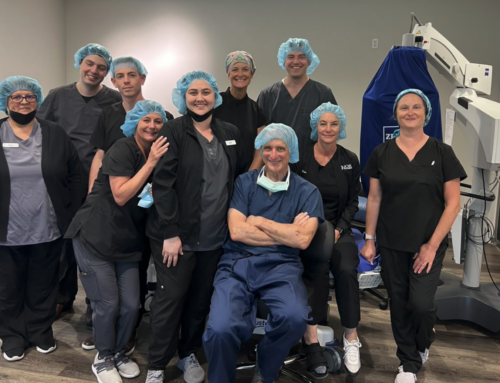
Many people with cataracts don’t realize they also have dry eye or another ocular surface disease (OSD). Left undetected, OSDs can distort vision and cause patients to receive the wrong artificial lens, or IOL, during cataract surgery. This can lead to months of discomfort and poor vision. Here’s why you should ask your ophthalmologist about OSD testing prior to cataract surgery.
If You Have Cataracts, You May Also Have Dry Eye
If you have a cataract, odds are that you also have dry eye or another OSD such as blepharitis or allergic conjunctivitis, even if you haven’t been diagnosed with it.
Ocular surface diseases prevent the eyes from producing enough tears or the right quality of tears. There are many different causes and subtypes of OSD. Symptoms include red, watery, irritated and itchy eyes and fluctuating blurry vision.
A cataract is a cloudy area in the lens of the eye that leads to a decrease in vision. If you have a cataract, you may see faded colors, have blurry vision, glare and trouble with bright and/or seeing at night.
“There’s an overlap in cataract and ocular surface disease symptoms: blurry vision,” said Academy member Christopher Starr, MD, an associate professor of ophthalmology at Weill Cornell Medical Center. “Cataract patients who experience intermittent blurriness or other fluctuations in their vision throughout the day often assume this is related to their cataract, when in fact the culprit is often untreated ocular surface disease.”
Both eye conditions become more common with age, and studies suggest that anywhere between 50% to 75% of those with cataracts also have dry eye disease or another type of OSD. While cataracts are more regularly diagnosed, OSD often goes undetected.
It’s important to treat ocular surface disease before proceeding with cataract surgery. If you don’t address it first, you may be less satisfied with your vision results afterward.
Four Reasons to Address Dry Eye Before Cataract Surgery
A healthy ocular surface is essential to achieving your best vision. Comprised of your cornea and tear film, the ocular surface supplies two thirds of the optical power in your eye, according to Dr. Starr. The last third comes from your lens, which is the part that gets replaced during cataract surgery.
Ocular surface disease can affect calculations for the IOL that will replace your natural lens during cataract surgery. Your surgeon measures your eye to determine the proper focusing power for your IOL. If your tear film is irregular, your ocular surface dry or your vision fluctuates due to OSD, that can lead to data errors during the measurement process. These errors can result in an IOL that may not be ideal for your eyes. You may be left with some residual far sightedness, near sightedness or astigmatism after surgery.
Cataract surgery can often temporarily worsen OSD or lead to a dry eye flare. The incisions made during surgery can upset the balance of your tear film and coular surface homeostasis. Eye drops used pre- and post-operatively—including topical anesthetic, steroid and antibiotic drops—often contain preservatives that are likely to irritate your ocular surface. Exposure to irrigation, drying and light from the operating microscope during surgery can cause some damage to the corneal and conjunctival surface, aggravating OSD symptoms. Even if OSD is mild before surgery, worsening symptoms can last for several months afterward, negatively affecting your vision.
Some forms of OSD are contagious and, if left untreated, can increase the risk of an infection after cataract surgery. Bacterial conjunctivitis and some forms of anterior blepharitis are common causes of OSD where active bacteria may be present on the eyelid margin. If this bacteria gets into the eye during surgery, it can lead to a serious and vision-threatening infection.
How Doctors Diagnose and Treat Ocular Surface Diseases
Your ophthalmologist should screen and examine your eyes for ocular surface disease prior to cataract surgery. This screening may include questionnaires, a thorough ocular surface exam and, in some cases, special testing such as:
Tearlab Osmolarity System: This tool can determine if you have dry eye disease and how severe it is.
InflammaDry: This test detects an inflammatory molecule that is often elevated in the tears of patients with various ocular surface diseases.
If you are diagnosed with an OSD, you’ll want to treat it as quickly as possible to be able to proceed with your cataract surgery. However, finding the right solution may involve some trial and error. Many people need to combine therapies and make a few lifestyle changes. Depending on the severity and sub-type of your OSD, you may need to delay your cataract surgery to get your ocular surface disease under control first.
To treat OSD your doctor may prescribe:
- Topical medications or pills that prevent inflammation and infection
- FDA-approved drugs such as Restasis, Xiidra, Cequa or Eyesuvis
- Devices such as LipiFlow, TearCare, Blephex and/or specialty contact lenses
- Punctal plugs
You may need to start one or more of these treatments prior to surgery for a pre-emptive strike. After surgery, treatments may need to be continued or adjusted to manage worsening symptoms.
“Today, expectations for cataract surgery are the highest they’ve ever been thanks to advanced surgical techniques and premium artificial lenses. That’s why it’s more important than ever for ocular surface disease to be diagnosed and treated ahead of time, so that patients aren’t disappointed with an unsatisfactory visual outcome,” said Dr. Starr.
This article courtesy of AAO – Read this story on the Eyesmart website
 Our practice philosophy at Barth Vision & Optical is simple, though we like to think it reflects a profound sentiment. We are here to be of service, in the truest sense of the term. We offer State-of-the-art eye examinations, A unique collection of fashion eye wear, Cataract surgery & consultation, LASIK vision correction, Eye Care Telemedicine. Call Today for an Appointment (707) 955-1120.
Our practice philosophy at Barth Vision & Optical is simple, though we like to think it reflects a profound sentiment. We are here to be of service, in the truest sense of the term. We offer State-of-the-art eye examinations, A unique collection of fashion eye wear, Cataract surgery & consultation, LASIK vision correction, Eye Care Telemedicine. Call Today for an Appointment (707) 955-1120.


